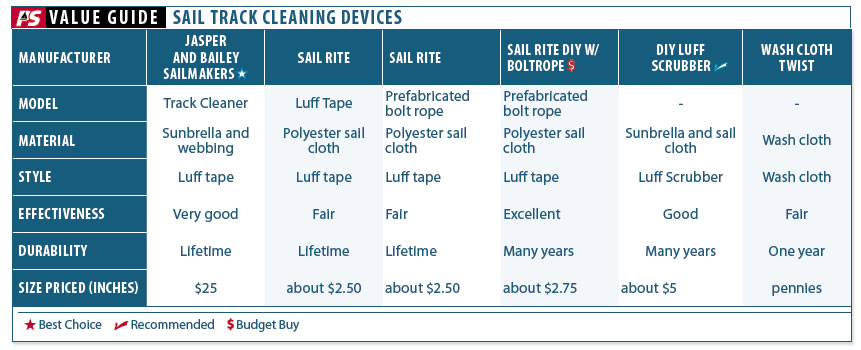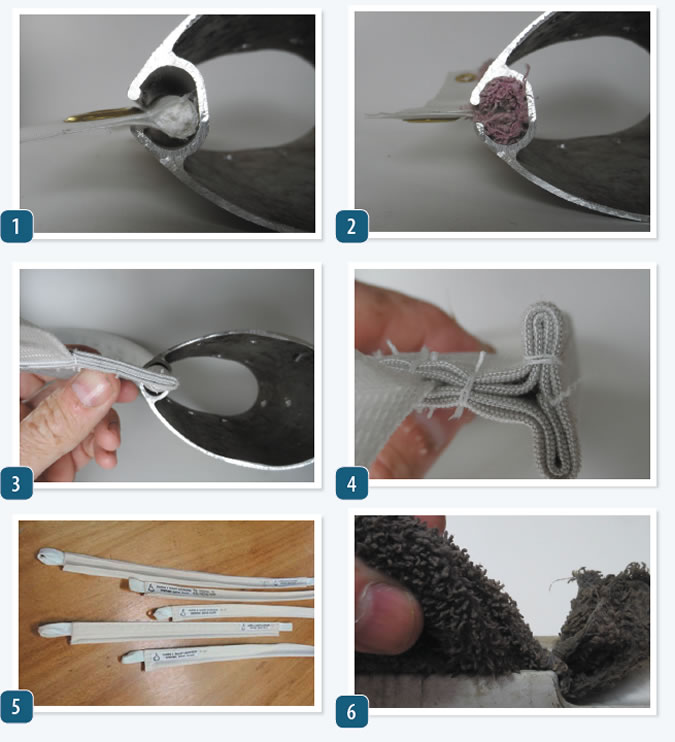Racers demand lightning-fast hoists. Cruisers tire of the effort required to grind a heavy main up a sticky track. Roller furler foils that have been left vacan’t over the winter can always do with a quick clean and lube before hoisting the genoa. But how can we accomplish this with minimal effort, without climbing the mast? Although it seems like the most common of tasks, the local chandlery doesn’t carry what we need, and its slim pickings on the internet. Even calls to sailmakers and lube vendors yielded sparse information. Oddly, patents abound, but no products.
What We Tested
We tested one commercial groove cleaner and four DIY variations, including one that can be inserted directly into the groove without access to the mast gate. This test was meant to evaluate products that work with your existing luff groove and slides. In some cases, either the luff track or slides will need replacing, in which case you’ll want to refer to our extensive survey of luff and mast track hardware upgrades.

How We Tested
Our test boat provided a good opportunity to evaluate the practicality of both foil and mast track cleaners. Since the mast gate is not easily accessed, we also developed an insertable cleaner. To test heavy duty cleaning ability, we tested on a broken mast section that had been lying in the leaf piles of the backyard for 30 years, accumulating mud and wasp nests.
Observations
We used McLube Sailkote in this round of testing (alternative lubes were testing in Sail Track Lubes: Slide-All Lasts Longest, Practical Sailor, August 15, 1999.) The most import consideration for a track lube is that it does not build-up or attract dirt.
Some have suggested soap, either in the form of hand dishwashing soap squirted on the sliders or a bit of bar soap trimmed to fit on top of a slider. While this works for some folks, we found that the rain did not reliably rinse out the soap, that rinsing with a hose from deck level was ineffective, and that soap residue made hoisting more difficult. We intensely dislike candle wax because it builds-up and attracts dirt; we learned that lesson years ago.
Sails can jam or be difficult to hoist for reasons unrelated to dirt or lack of lubrication. Sail slugs (sliders) that are too small or worn can turn cross-wise and jam. A headsail foil may be twisted, or there may be burrs between sections of foil or mast. The masthead sheaves may jam, and in the case of roller furling head sails, friction on the halyard or wear in the top furler bearing often combine to but make hoisting nearly impossible even when dropping the sail is easy. This is because the hoisting and dousing a sail create different types of tension on the furler.
If the cleaning and lubricating the halyard, tracks, or sheaves with Sailkote or a similar dry lubricant don’t resolve this resolve the problem, a trip up the mast to inspect all of the components is in order. As a reference point, you should be able to hoist the sails of a 30- to 35-foot boat by hauling with full body weight on the halyards at the mast without resorting to a winch until the last few feet. This is often not possible when lines are routed to the cockpit, since this adds a variable amount of friction.
Direct Insertion Cleaner
We looked high and low for a product that might be able to clean the mast luff groove without accessing the often difficult to access the track gate and found none-so we made our own.
DIY Luff Track Cleaner
Based on the notion that a pile of fabric can be slid into a groove and then cinched up in such a way that it cannot come back out, we created a cleaner that did not require an accessible track gate.
Although it is a little fussy to fabricate (see Making DIY Track Cleaners sidebar) and insert, once we had the hang of it, this clever tool proved considerably faster than removing slugs, spilling the sail on deck, opening the gate, and then putting everything back together. The fat bundle of Sunbrella did a reasonably good job of cleaning and lubing a groove that was not extremely dirty.
Bottom line: Its a little tricky to work with but works well. Perhaps readers might have a suggested modification?
Gate Insertion
Although easier to use, this type requires an accessible mast gate.
Jasper and Bailey Track Cleaners
Superior to the other popular options-sail cloth of a prefabricated luff tapes or bolt ropes-these from cleaners are made of heavier woven fabric. They should last a lifetime, or at least many hundreds of laps up and down the mast.
It is custom made for a variety of luff groove shapes. According to Jasper and Bailey, the biggest problem they have is people not knowing the size of the groove, so measure carefully and ask Jasper and Bailey for advice. Each one is about three feet long.
Bottom line: These are our Best Choice, and perhaps the only choice for tracks that are not round. Jasper and Bailey make custom cleaners for any groove shape.
Sailrite Luff Tape
Plain luff tape fits exactly as the sail luff does. You could just coat your sails luff tape with Sailkote and make several passes, but that would waste lubricant However, a dedicated length of luff tape can be soaked in SailKote and quickly hauled to the top, and lubricate the track before it has a chance to dry out. We tested 12-inch-long sections, but in retrospect, a 3-foot section will deliver more contact and would be better for cleaning. A separate, 12-inch section should be fine for lubing.
Bottom line: This is our Best Buy for cleaning and lubing headsail foils.
Sailrite 3/8 Bolt Rope
Like the luff tape, it is cheap and effective. Costing only about $2.30/foot, there is no reason not to make up a handful and keep them around. Give some to friends for a gift. We experimented with fraying the rope at top and bottom for better cleaning, but it didnt make any difference and the rope tails didnt come down any dirtier. Again, we tested a 12-inch section, but believe a 3-foot section would work better for the cleaner.
Bottom line: This is our Budget Buy for round mast tracks.
DIY Bolt Rope Plus Terry Cloth
If well-fitted to the mast, this DIY modification delivers good cleaning and a good lube coating. Construction was a simple matter of deciding how much thickness was tolerable and gluing on the cloth. Terry cloth fit the rather large slot on the broken mast, but our test boat mast was better served by a single layer of Sunbrella. Fleece is another option. The amount of adhesive (we used polyurethane caulk) is another variable. They will last many seasons. We tested a 12-inch section-a longer section might give too much drag, so experiment.
Bottom line: This is our Budget Buy for those who arent satisfied with the pre-fabricated options.
Washcloth and a Knot
This solution was suggested by McLube the makers of Sailkote. Make a tight twist in the corner of a washcloth, insert this in the mast gate, and haul it up and down. We found this difficult to get just right; too loose and it fell out, to tight it was hard to pull up. Worse, when hauled back down, the washcloth folded over itself, jamming and requiring a trip up the mast to retrieve.
Bottom line: Not Recommended due to jamming potential.


Scrubbing and lubing the luff track only works if your cleaning device actually come into contact with the surface. In some cases, all it takes is a little modification to get the right fit.
- The bolt rope cleaner barely touches the sides of our test mast.
- Gluing terry cloth onto the bolt rope in photo #1 takes time, but afterward we have a custom fit.
- The Jasper and Bailey Cleaner has a tight compact entry that makes it easy to start.
- This T-shaped Jasper and Bailey cleaner is one of few options for T-tracks.
- Jasper and Bailey cleaners come in a variety of sizes to fit most tracks.
- Once suggested by McLube, a twisted washcloth might work on some masts. We found it too tricky.

































